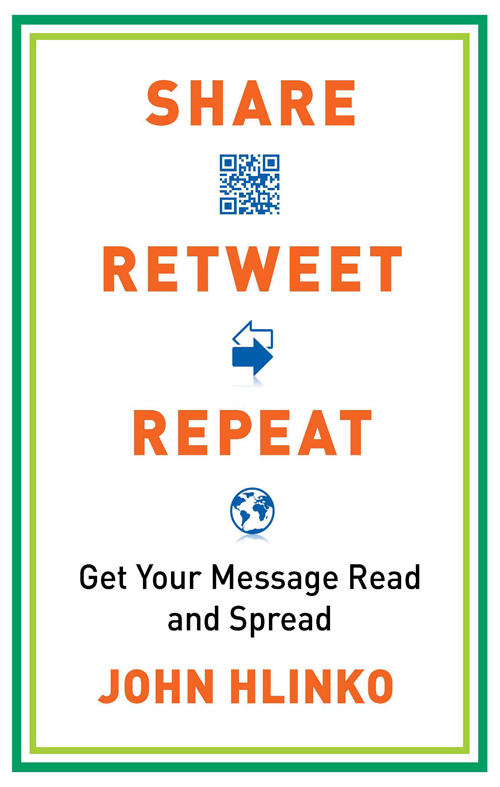 Books about online marketing are hit or miss. They’re either just too basic, or else they’re bone dry technical. But the latest contribution to the genre – “Share, Retweet, Repeat: Get Your Message Read and Spread” -- from veteran online marketing whiz John Hlinko, is a terrific read. In fact it should be scooped up by any Frogloop reader who aspires to getting their messages to “go viral.”
Books about online marketing are hit or miss. They’re either just too basic, or else they’re bone dry technical. But the latest contribution to the genre – “Share, Retweet, Repeat: Get Your Message Read and Spread” -- from veteran online marketing whiz John Hlinko, is a terrific read. In fact it should be scooped up by any Frogloop reader who aspires to getting their messages to “go viral.”
And that’s why we’re going to hold a February 1st drawing to give away three free copies of Hlinko’s book to Frogloop readers. To be in the drawing, all you need to do is write a comment on this post (a relevant one, please), and then click the button to share the post via Facebook or Twitter before midnight on Jan. 31st. It will only take a minute and, trust me, you’ll be really happy if you win this book.
Hlinko’s book deconstructs the most successful online campaigns, dissecting their opening premises, their  attention grabber “hooks,” their visual aids, their choice of messengers and their distribution and promotion tactics. In this way, he identifies which elements helped the most in making the campaigns "go viral." And his tips for using Facebook, Twitter, blogs and email are up to date and first rate. Most importantly though, this book is genuinely fun to read. It obviously was written to make us laugh while we learn.
attention grabber “hooks,” their visual aids, their choice of messengers and their distribution and promotion tactics. In this way, he identifies which elements helped the most in making the campaigns "go viral." And his tips for using Facebook, Twitter, blogs and email are up to date and first rate. Most importantly though, this book is genuinely fun to read. It obviously was written to make us laugh while we learn.
It helps that Hlinko is possibly the most gifted wit in the progressive politics and advocacy space, deftly mixing satire and puns to grab you, make you smile, and get you to forward his stuff to your friends. Just read John’s posts on Progressive Exchange, sometimes in repartee with Sea Change Strategies Mark Rovner, and you’ll see what I mean. Or check out his bio, here. Hlinko is also a veteran of the commercial marketing world, having worked with leading ad agency creative directors. This enables him to provide great examples to illustrate points.
Along with Seth Godin’s books, and the great “Made to Stick” by Chip Heath and Dan Heath, this new online marketing gem -- “Share, Retweet, Repeat” -- definitely deserves to be on your shelf of really useful books about creative messaging and marketing. You’ll read it at one long sitting and then refer to it again and again.
Below is an Exclusive Interview with the author himself.
FIVE INSIGHTFUL QUESTIONS AND ANSWERS WITH AUTHOR JOHN HLINKO
CO: OK here is my one serious question for you: In talking about advertising options, you discuss Cost per Thousand ("CPM") pricing and Cost per Click ("CPC") pricing. Why didn't you include "Cost per Lead" (CPL) pricing -- such as we use for Care2 clients?
 JH: I love CPL/CPA pricing, and strongly recommend it (and Care2) for the right clients, especially those in the advocacy space! The advertising section was a smaller piece of this book, so I didn't get to include as much about that approach, but I'm brainstorming another book that would definitely include that as a key component.
JH: I love CPL/CPA pricing, and strongly recommend it (and Care2) for the right clients, especially those in the advocacy space! The advertising section was a smaller piece of this book, so I didn't get to include as much about that approach, but I'm brainstorming another book that would definitely include that as a key component.
Frankly, this goes near the top of the very long list of things that I would have loved to include -- and that motivate me now to keep writing! :)
CO: Your book gives lots of examples to illustrate ideas and techniques. Some are about sex. And a LOT of your examples have to do with wine, and wine shops. Is this a not-so-subtle hint that you'd rather be running a vineyard in Napa or something?
JH:Well, I am half Italian, so examples about wine (and yes, sex), just seemed to come oh so naturally.
But to be honest, I think that including some fun and even racy examples were done as part of an effort to practice what I preach with the book. If the examples are fun and even a little edgy, they're far more likely to make an impact -- and to get shared, retweeted and repeated!
CO: In chapter 21 you talk a lot about ways to combat "Joy Sponges," which is how you describe risk-averse people in brainstorm sessions who try to kill all the most creative and possibly viral ideas by other participants. I had to wonder if maybe you've been a victim of a lot of Joy Sponges in your career and so now you're trying to settle a score. True?
JH: Oh, I think anyone who's ever had a creative idea has been of victim of a joy sponge at least once, and I'm no exception! Joy sponges are the people who suck the joy out of life, and squelch great ideas that could go viral, and could make a profound impact.
THREE FUNNY EXCERPTS from "Share, Retweet, Repeat"
- If you’ve ever surfed, known a surfer, or even just seen that clas- sic Brady Bunch episode where the gang goes to Hawaii, you know that surfing requires a wave. Sure, it’s possible to create one by splashing your own hands, but it’s a heck of a lot more efficient to ride the one that the ocean has already produced. If you’re looking for virality, keep this in mind when you craft your content. Try to ride an existing wave.
- Let’s say I post a tweet that catches the interest of @John_Doe. Here’s how the exchange might go (notes in paren- theses):
JHLINKO: I just flew in from Reno and, boy, are my arms tired!
JOHN_DOE: I can’t believe @JHlinko used that lame joke! (Followers of John_Doe would see this tweet, and the @JHlinko would be hyperlinked back to my page, Twitter.com/JHlinko.)
JHLINKO: Hey, you’re the one that retweeted it! @John_Doe I can’t believe @JHlinko used that lame joke! (My followers would now be able to click @John_Doe to go to his page.) - We’ve gone to the moon, we’ve split the atom, and we’ve even managed to create cola with zero calories. Impressive stuff, to be sure, but don’t let yourself be fooled. At our core, human beings are just well-dressed monkeys.
I think the key thing is to differentiate between those who have an honest, evidence-driven argument why a creative technique might not work -- and those who are simply shying away from it due to irrational and overblown fears.
It's always a lot easier to push back on creativity, since no one ever got fired for playing it safe. But if you're constantly playing it safe out of fear, then you've dramatically reduced your odds of producing something awesome and "spread-worthy."
The true revolutionaries know that playing it smart doesn't always mean playing it safe.
CO: Lots of books like this urge people to "test, test, test" their online messages. But in your book, I noticed on p. 122 that you instead urge people to "Test, test, test, test." Can you talk a bit about the "science-y" research you did to determine that the secret is really that FOURTH round of testing?
JH: Well, they say good things come in threes, so I suppose the fourth "test" must have been my subconscious homage to Spinal Tap, and their speakers that "go to 11." I mean, if threes are "good," then fours must be AWESOME!
CO: Your book is 210 pages long. How did you come up with that number? Did you test that number with audiences? Would you have made it longer, if not for the influence of some nasty Joy Sponge?
JH: Well, if I'd been actually under any "influence," I suppose I would have doubled it and made it "420." But honestly, there's something about 210 that apparently seems to work extremely well for books in this category. It's that sweet spot where people feel they've learned enough to justify the purchase price, but they haven't had to read so much that they go nuts, and feel a need to find the author and get medieval on him.
At one point, when I was advised that 60,000 words was a good length, I suggested using 120 point font, so we could do one word a page, and then have a 60,000 word book. How cool would that be? Well, apparently not very cool in the real world of publishing, so... 210 pages it was. :)
SPECIAL SIXTH BONUS QUESTION
CO: You seem to like using the phrase "ass clown," especially in reference to right wing blowhards. "Ass clown" is fun to say. But where did that phrase come from, anyway?
JH: Oh, I love that phrase. I first heard it in the movie "Office Space," which really is one of the greatest works of art in human history. My understanding is that it's someone who really is just an ass, but has an almost magical clown quality to their assininity (is that even a word?).
And yeah, I will say, working with at least one foot in the world of politics, I am finding a LOT of reasons to use that term these days.


COMMENTS